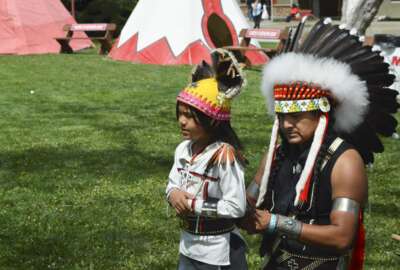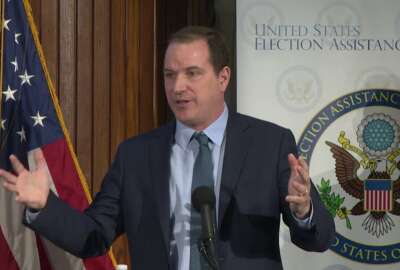
DOJ set up task force for missing Native Americans and Alaskan Natives
American Indians and Alaska Natives have disproportionate levels of murder and missing persons so the Justice Department set up a presidential task force.
Best listening experience is on Chrome, Firefox or Safari. Subscribe to Federal Drive’s daily audio interviews on Apple Podcasts or PodcastOne.
For a variety of reasons, American Indians and Alaska Natives have disproportionate levels of murder and missing persons. So much so that the Justice Department set up a presidential task force to try and mitigate it. With more on the task force and its activities, Federal Drive with Tom Temin spoke to Principal Deputy Assistant Attorney General for the Office of Justice Programs, Katie Sullivan.
Interview transcript:
Tom Temin: Mrs. Sullivan, good to have you on.
Katie Sullivan: Hi Tom. Good to be on. Thank you.
Tom Temin: Tell us. First of all, the background here. What is going on in the American Indian and Alaska Native populations that they have this issue?
Katie Sullivan: Well, I think that what is happening in our Indian country and with Alaskan Natives is that there are missing people and murdered people. There’s jurisdictional issues. There’s issues of geography. Quite frankly, that is the completely rural nature of many of our tribes, and certainly in Alaska, that make it very difficult for a coordinated with response when someone does go missing and or is murdered. So what we’re trying to do is to close some of the gaps, look at closed cases and we’re really trying to get a handle on data so that we can actually know where the concentration of issues so that we can put resource is we can come together with our other agencies in order to try to help Indian country reduce and reverse this trend.
Tom Temin: Because many of those areas may have one or two sworn officers to cover hundreds of square miles, or it could be days or hours before they can respond to everything that happens. Is that one of the problems?
Katie Sullivan: It is. I think that was most notable when I went with the Attorney General, Attorney General Barr, to Alaska. And on our trip to Alaska, we not only had meetings with many of the federation’s and different groups, we also went up to see a village in a river boat. So we went in river boats up to a village and they have no roads. There are certain times during the year where they’re cut off from their hub, which is Bethel. It would be very difficulty if someone reported a serious crime or someone went missing. It could take days for state patrol to get there because of weather and other difficulties. I think actually seeing that, and I know the Attorney General was extremely moved when he saw that firsthand, and could understand the public safety issue. Now that is not unique to Alaska. When you come down and you look at, say, some of the tribes and we also visited with the Attorney General of Montana and you see some of the Indian country in Montana, they have very similar issues. So certain tribes may have some tribal law enforcement. They then have to coordinate with the Department of Interior, which is the Bureau of Indian Affairs. Bureau of Indian Affairs, depending on the level of crime, then has to coordinate with the FBI. And so you have these issues with jurisdiction.
Tom Temin: Sure. And how is the task force organized? Who’s on it? And where does it live within the Office of Justice programs?
Katie Sullivan: I was so excited when President Trump directed the creation of this task force in November of 2019. He wanted to address this problem of missing and murdered American Indians and Alaska Natives. The Attorney General and the Secretary of the Interior Service co-chairs. I have the honor of serving as the Attorney General’s designee and representative on the task force as a co-chair. Along with assistant Secretary Tara Sweeney from the Department of Interior, who served as Secretary Bernhardt’s representative. We also have the Health and Human Services, we have the FBI, the Office of Violence Against Women, and we have the head of the Bureau of Indian Affairs, which is Charles Addington. And he runs the law enforcement piece of BIA.
Tom Temin: And what has the task force done so far? What are your initial activities here?
Katie Sullivan: It’s great that you asked that. It’s an interesting time. Our first goal was to work in a government to government way. The federal government has a trust responsibility to our Indian and Native American and Alaskan Native partners. So the first thing we have to do is to bring them in through listening sessions as well as formal consultations. So we have a very robust listening session and consultation schedule. We have had multiple listening sessions already, in which we’re getting feedback from our Native American partners to find out what are their concerns? What are their challenges? What are some examples of what’s worked in their communities? And So first thing we need to do is to make sure that we are partnering in the way that we are supposed to partner with sovereign nations. So that’s our first task. We have another work stream that’s happening at the same time, which is we’re developing policies and protocols. We are coming up with a plan to collect data. As I said, data collection and analyzing is a very important part of this. We also will be educating people on NaMus (National Missing and Unidentified Persons System) and doing an educational and sort of outreach program on NaMus. So each one of the department has a different focus in a different work stream. But what I love about this task force is how we are truly so mission driven and working together, which is how it should be. We need to work together, inter-agency in the federal government with our partners, Alaskan Natives and Native Americans to solve this issue.
Tom Temin: One more time NamUs is?
Katie Sullivan: NamUs stands for National Missing and Unidentified Persons System. It’s a program where you can go online and report someone who’s missing. Anybody can go on. What we do is encourage law enforcement, tribal law enforcement etc. to go on and report someone who is missing and then also go when that person is found or heard from. So what’s tricky is we don’t have a really perfect number because if you look at it often times, people will report someone who’s missing. But they may not go on lot back online and report that someone has been found. People also have the capability of putting on, you know, if someone has a tattoo or something that is defining about their features so that they can be looked for more easily.
Tom Temin: And in these learning sessions and feedback sessions, have any possible courses of action for the federal government to take come to mind yet?
Katie Sullivan: Yes, I mean, I definitely think so. Particularly with our FBI partners, and they’ll be heading up the NamUs portion of things. HHS is working on an education and outreach plan, and then the Department of Justice is working on coming up with policies and protocols that then can be disseminated. While we will have some policies and protocols that we will recommend for how we deal with these cases. At the same time, Tom, it is very important to understand that every single tried is different. You’ve gone to one tribe you’ve seen you’ve heard from them, there needs may be very different from another tribe, right? We also have an emerging population of Native Americans and Alaskan Natives in urban communities. So we need to figure out how to assist those people to bring culturally competent services to them. So policies and protocols are going to have to be written in a way that can pivot to the needs of each one of our partners. The Department of Interior is creating cold case teams. Those will be multidisciplinary teams so we can start to look at some of these older cases of people who have gone missing. And then separate from the president’s task force. the Attorney General did announce an initiative in which we are looking at immediate responses, so it’s very operational in its mission. And that is, if someone goes missing, how are we responding to those cases. So we’re placing program coordinators and U. S attorney’s offices in 11 different districts in order to head up community teams to be ready to respond to missing case is moving forward. We’re looking at the older cases and moving forward operationally as well.
Tom Temin: Katie Sullivan is principal deputy assistant attorney general in the Office of Justice Programs. Thanks so much for joining me.
Katie Sullivan: Thank you Tom. I appreciate it.
Copyright © 2024 Federal News Network. All rights reserved. This website is not intended for users located within the European Economic Area.



